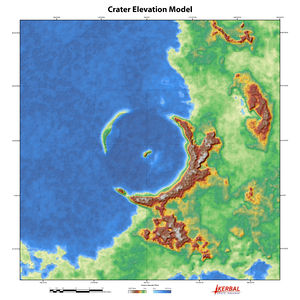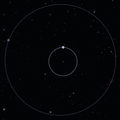Kerbin
Kerbin is the home planet of the Kerbals, the location of the Space Center, and the main focus of Kerbal Space Program. It is also the Earth analog for the game and has two moons, named Mün and Minmus.
Kerbin is the third planet in orbit around the star Kerbol. It is the third largest planet (after Jool and Eve) and the fourth largest celestial object around Kerbol (with Tylo, a moon of Jool, being slightly larger).
Reaching a stable orbit around Kerbin is one of the first milestones a player might achieve in the game. Doing so with a fuel-optimal ascent[1] requires a delta-V of ≈4500 m/s,[2] the second largest of all celestial bodies with a solid surface after Eve. Many interplanetary missions expend over half of their delta-V in reaching Kerbin orbit. Many Earth-based interplanetary spaceflights also do so, leading one observer to remark:
| “ | If you can get your ship into orbit, you're halfway to anywhere. — Robert Heinlein, quoted on page 194 of A Step Farther Out by Jerry Pournelle |
” |
Contents
Topography
Kerbin has a roughly equal distribution of surface liquid water and solid land, with polar icecaps and scattered deserts. Some of its mountains exceed 6 km in height, with the tallest peak being 6761 m in altitude.
Craters
Unlike other bodies in its system, Kerbin has few visible craters because its environment would erode craters from the few meteors that avoid the gravity or surface of its large moon and survive reentry. Nevertheless, some geological formations indicate that bodies have violently collided with Kerbin: two planetary features appear to be impact craters that are coincidentally separated by nearly 180 degrees. The least eroded, and therefore presumably youngest, of the two (both are in excess of 100 km diameter) lies along the coastline. The uplift is easily visible as a series of islands, and the feature has a central peak that pokes up through the water. The other, and older of the two, is near the prime meridian in the northern hemisphere and is more easily missed, but its uplift rims are visible, and it has a central rebound peak.
Atmosphere
Kerbin's atmosphere contains oxygen and extends to roughly 69,078 meters. Its atmosphere exponentially rarefies with altitude (with a scale height of 5 km).[3] The atmospheric pressure on Kerbin at an altitude expressed in meters, generally is:
The thickness of Kerbin's atmosphere makes it suitable for aerobraking and using parachutes to save fuel during reentry. Debris is not affected by air resistance above approximately 10 km: spent stages may continue in a stable orbit even if they are going through thick atmosphere that would stop an active craft (0.19). Crafts will experience harmless re entry and supersonic air effects as of 0.19.
The following table gives approximation of terminal velocities at different Kerbin altitudes, which are also the velocities at which a ship should travel for a fuel-optimal vertical ascent from Kerbin, given the game's model of atmospheric drag.[4] The optimal velocity after a gravity turn has been started is less than the corresponding value in the table. [5]
| Altitude (m) | Velocity (m/s) |
|---|---|
| 75 | 107 |
| 1000 | 114 |
| 2000 | 124 |
| 3000 | 136 |
| 4000 | 152 |
| 5000 | 169 |
| 6000 | 188 |
| 7000 | 209 |
| 8000 | 232 |
| 9000 | 256 |
| 10000 | 281 |
| 12500 | 348 |
| 15000 | 419 |
| 20000 | 566 |
| 32000 | 2250 |
Orbits
Geosynchronous orbit is achieved at an altitude of 0.00 m and a speed of Expression error: Unexpected < operator. m/s. From a 70 km low equatorial orbit, the periapsis maneuver requires 676.5 m/s and the apoapsis maneuver requires 434.9 m/s. A semi-synchronous orbit with an orbital period of 1/2 of Kerbin's rotation period (3 hours or 10800 seconds) is achieved at an altitude of 0.00 m with an orbital velocity of Expression error: Unexpected < operator. m/s.
The Hill Sphere (the radius around the planet at which moons are gravitationally stable) of Kerbin is 136 185km, or roughly 227 Kerbin radii.
Interplanetary Travel
From the lowest stable orbit around Kerbin (70 km), the amount of delta-V needed to reach the orbits of other celestials is:
| Body | Delta-V |
|---|---|
| Mun | ~860 m/s |
| Minmus | ~930 m/s |
| Eve | ~1033 m/s |
| Duna | ~1060 m/s |
| Moho | ~1676 m/s |
| Jool | ~1915 m/s |
| Eeloo | ~2100 m/s |
| KEO (comparison) | ~1120 m/s |
Reference Frames
| Time warp | Minimum Altitude |
|---|---|
| 1× | Any |
| 5× | 70 000 m (above the atmosphere) |
| 10× | 70 000 m (above the atmosphere) |
| 50× | 70 000 m (above the atmosphere) |
| 100× | 120 000 m |
| 1 000× | 240 000 m |
| 10 000× | 480 000 m |
| 100 000× | 600 000 m |
Gallery
Topographical map of Kerbin as of version 0.21
- NJ6qJ.jpg
A projection map of Kerbin, as of 0.14.1 and before (including the old demo).
Topographical image of Kerbin from 0.17.1. The terrain is slightly different in the latest version.[6]
Changes
- Terrain revised to produce more detailed and interesting landforms.
- Fixed ladders on the fuel tanks near the launchpad.
- New mesh for the launchpad and area (no launchtower anymore).
- New mesh for the runway, with lights and sloping edges for rovers.
- Terrain overhaul: Entire planet redo. Deserts, darker and greener grass, islands, darker ocean/water, snow capped mountains. Looks more realistic.
- Several Easter Eggs added.
- Airport added to island off of KSC coastline. (Not a launching point)
- Improved atmosphere visuals.
- Minmus added.
- Much more varied and taller terrain added. Prior to this, some mountain ranges exceeded 600 m in height, but the tallest point was at an altitude of approximately 900 m.
- Mün added.
- Terrain overhaul, oceans became wet.
- Atmosphere extended from ~34,500 m to ~69,000 m.
- Initial Release
Trivia
Kerbin's continents are derived from libnoise [7], though they have been increasingly modified with time.
Notes
- ↑ A fuel-optimal ascent is one which (a) minimizes velocity losses to gravity and atmospheric drag and (b) launches eastward (toward the 90 degree heading) to gain 174.5 m/s of orbital velocity for free, thanks to Kerbin's rotation.
- ↑ See this challenge on the forum and a popular Kerbin delta-V chart
- ↑ Forum thread 16000, "[KGSS] Examining Kerbin's atmosphere"
- ↑ http://forum.kerbalspaceprogram.com/showthread.php/6664-Mini-challenge-max-altitude-with-this-supplied-spacecraft?p=100912&viewfull=1#post100912
- ↑ http://www.reddit.com/r/KerbalSpaceProgram/comments/1kov5z/a_handy_chart_i_made_for_the_most_efficient/cbrdvuo
- ↑ http://forum.kerbalspaceprogram.com/entry.php/247-A-Brave-New-World
- ↑ http://libnoise.sourceforge.net/examples/complexplanet/














